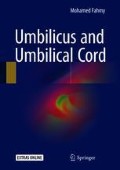Abstract
The most frequent umbilical mass in neonates is the umbilical granuloma followed by the umbilical polyp; most of UP are congenital, and few entities are an acquired lesions, but we opted to discuss this pathology with the acquired lesions because of the resemblance between UP and U granuloma and to give some clues for differentiation between those different pathologies, with some shared features. After cord stump separation, the umbilical scar covered by a normal skin, any abnormal mucosal overgrowth at the umbilical base, which may result in a polypoid mass; most of literatures are describing only one type of UP, which is a remnant of the omphalomesenteric duct, but herein all possible types of UP will be classified and described. These polyps are rare abnormalities and are usually diagnosed in neonates, especially the congenital one, although lesions have been found in older children and also in adults, but in the latter they are exceptional, and it is usually neoplastic, and of course it is an acquired lesion, with a wide spectrum of different pathologies. Clinically UP presents as a small round swelling, with red, smooth surface and shiny appearance because it is mucosa, covered with serosity and located at the base of the umbilicus. Differential diagnosis of this polyp may pose difficulties, especially with umbilical granuloma because of its clinical similarity; with a more frequent presentation, granuloma is mainly distinguished by its smaller size and the good response that it presents to topical treatment, whereas in the polyp the treatment is surgical. Other entities to be differentiate from UP are persistence of urachus, omphalocele, haemangiomas and keloid umbilical scar. In UP the histopathological study of the lesion shows an abrupt transition from squamous epithelium to an intestinal, colonic or gastric glandular epithelium and less frequently pancreatic tissue. In adults, metastases from intra-abdominal tumors need to be excluded. Diagnosis of UP is usually made by physical exam, which may demonstrate a watery discharge from the umbilicus, imaging, including ultrasound, computerized tomography, fistulogram or voiding cystourethrography, which could also be useful in the diagnosis of patent urachus. Surgical excision of UP is mandatory with or without abdominal exploration to detect any other associated anomalies.
References
Sánchez-Castellanos M, Sandoval-Tress C, Hernández-Torres M. Persistencia del conducto onfalomesentérico: Diagnóstico diferencial de granuloma umbilical en la infancia. Actas Dermosifiliogr. 2006;97:404–5.
Fitz R. Persistent omphalomesenteric remains, their importance in the causation of intestinal duplication, cyst formation, and obstruction. Am J Med Sci. 1884;88(175):30–57.
Aitken J. Remnants of the vitellointestinal duct a clinical analysis of 88 cases. Arch Dis Child. 1953;28(137):1–7.
Kittle CF, Jenkins HP, Dragstedt LR. Patent omphalomesenteric duct and its relation to diverticulum of Meckel. Arch Surg. 1947;54:10–36.
Heatly MK, Mirakhur M. Cutaneous remnants of the vitellointestinal duct: a clinic-pathological study of 19 cases. Ulster Med J. 1988;57(2):181–3.
Storms P, Pexters J, Vandekerkhof J. Small omphalocele with ileal prolapse through patent omphalomesenteric duct a case report and review of literature. Acta Chil Belg. 1988;88:392–4.
Taranath A, Lam A. Ultrasonographic demonstration of a type 1 omphalomesenteric duct remnant. Acta Readiol. 2006;47:100–2.
Thomson JE. Perforated peptic ulcer in Meckel's diverticulum. Ann Surg. 1937;105:44.
Steck WD, Helwig EB. Cutaneous remnant of the omphalomesenteric duct. Arch Dermatol. 1964;90:463–70.
Kutin ND, Allen JE, Jewett TC. The umbilical polyp. J Pediatr Surg. 1979;14(6):741–4.
Pacilli M, Sebire NJ, Maritsi D, Kiely EM, Drake DP, Curry J, Pierro A. Umbilical polyp in infants and children. Eur J Pediatr Surg. 2007;17(6):397–9.
Jessica W, Hsu BS, Wynnis L. Tom: omphalomesenteric duct remnants: umbilical versus umbilical cord lesions. Pediatr Dermatol. 2011;28(4):404–7.
Oğuzkurt P, Kotiloğlu E, Tanyel FC, Hiçsönmez A. Umbilical polyp originating from urachal remnants. Turk J Pediatr. 1996;38(3):371–4.
Bambirra EA, Miranda D. Gastric polyp of the umbilicus in an 8-year-old boy. Clin Pediatr. 1980;19(6):430–2. doi:10.1177/000992288001900609.
Iwasaki M, Taira K, Kobayashi H, Saiga T. Umbilical cyst containing ectopic gastric mucosa originating from an omphalomesenteric duct remnant. J Pediatr Surg. 2009;44:2399–401.
Cevik M, Boleken ME, Kadıoglu E. Appendicoumbilical fistula: a rare reason for neonatal umbilical mass. Case Rep Med. 2011;2011:2. doi:10.1155/2011/835474W.T.
Lee WT, Tseng HI, Lin JY, et al. Ectopic pancreatic tissue presenting as an umbilical mass in a newborn: a case report. Kaohsiung J Med Sci. 2005;21(2):84–7.
Vargas SO. Fibrous umbilical polyp: a distinct fasciitis-like proliferation of early childhood with a marked male predominance. Am J Surg Pathol. 2001;25:1438–42.
Ford T, Widgerow AD. Umbilical keloid: an early start. Ann Plast Surg. 1990;25:214–5.
Stock N, et al. Umbilical polyp in an infant. Pediatr Dev Pathol. 2008;11:165–6. doi:10.2350/07-09-0342.1.
Author information
Authors and Affiliations
Rights and permissions
Copyright information
© 2018 Springer International Publishing AG
About this chapter
Cite this chapter
Fahmy, M. (2018). Umbilical Polyp (UP). In: Umbilicus and Umbilical Cord. Springer, Cham. https://doi.org/10.1007/978-3-319-62383-2_29
Download citation
DOI: https://doi.org/10.1007/978-3-319-62383-2_29
Published:
Publisher Name: Springer, Cham
Print ISBN: 978-3-319-62382-5
Online ISBN: 978-3-319-62383-2
eBook Packages: MedicineMedicine (R0)

